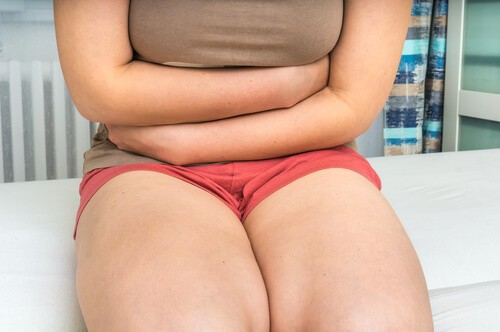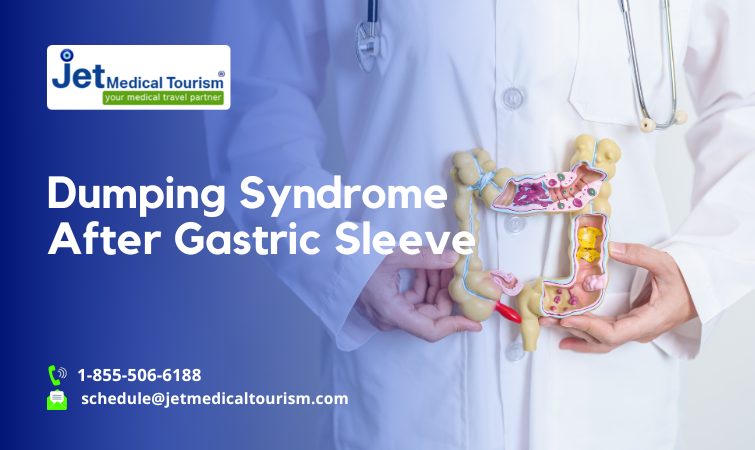Dumping Syndrome After Gastric Sleeve
Dumping syndrome after gastric sleeve is a common concern for patients who have undergone this weight loss surgery. It occurs when food moves too quickly from the stomach to the small intestine, leading to uncomfortable symptoms such as nausea, dizziness, and diarrhea. Understanding what dumping syndrome is, its causes, and how to prevent it can help patients manage their diet and lifestyle effectively post-surgery.
Understanding the symptoms, causes, and preventive measures is essential for those who have undergone gastric sleeve surgery (sleeve gastrectomy) or are considering it.
In this article, we will explore what dumping syndrome is, how to identify its symptoms, whether everyone experiences it, and strategies to prevent it. If you’re considering gastric sleeve surgery in Tijuana, Mexico, Jet Medical Tourism is here to guide you through every step of the process.
What Is Dumping Syndrome After Gastric Sleeve?

Dumping syndrome occurs when partially digested food moves too quickly from the stomach into the small intestine, causing a range of symptoms. This happens because, after gastric sleeve surgery, the stomach is significantly smaller and lacks the pyloric valve, which normally controls how food empties into the intestine.
Types of Dumping Syndrome
Dumping syndrome is classified into two types:
- Early Dumping Syndrome – Occurs within 10 to 30 minutes after eating. This is triggered by a rapid influx of food, causing fluid shifts in the intestines, leading to bloating, nausea, diarrhea, and dizziness.
- Late Dumping Syndrome – Occurs 1 to 3 hours after eating. It is caused by a sudden spike in blood sugar followed by an insulin overreaction, leading to hypoglycemia (low blood sugar). Symptoms include shakiness, weakness, sweating, and confusion.
How Common Is Dumping Syndrome After Gastric Sleeve?
According to a study published in the National Library of Medicine, up to 50% of gastric sleeve patients experience dumping syndrome to some degree (source: StatPearls). However, not everyone experiences severe symptoms, and most cases improve with proper dietary management.
What Causes Dumping Syndrome After Gastric Sleeve?
Dumping syndrome is primarily caused by changes in stomach function after surgery. Key reasons include:
1. Rapid Gastric Emptying
Since the gastric sleeve removes a large portion of the stomach, food moves much faster than before. This rapid transition disrupts digestion and leads to discomfort.
2. High-Sugar or High-Carbohydrate Foods
Consuming sugary foods (e.g., candy, soda, pastries) or refined carbohydrates (e.g., white bread, pasta) can trigger early and late dumping symptoms by causing sudden blood sugar spikes.
3. Consuming High-Fat Foods
Fatty and greasy foods slow digestion and can exacerbate nausea and diarrhea associated with dumping syndrome.
4. Drinking Liquids with Meals
Fluids consumed during meals can accelerate stomach emptying, worsening symptoms. Instead, wait 30 minutes before and after eating to drink fluids.
5. Eating Too Quickly
Rushed eating can overwhelm the stomach, forcing food into the small intestine prematurely. Chew each bite thoroughly to slow digestion.
How Do I Know If I Have Dumping Syndrome After Gastric Sleeve?
Symptoms of Early Dumping Syndrome (10–30 Minutes After Eating)
- Nausea and vomiting
- Abdominal cramping
- Bloating
- Diarrhea
- Dizziness
- Sweating
- Flushing
- Fast heart rate (tachycardia)
Symptoms of Late Dumping Syndrome (1–3 Hours After Eating)
- Weakness
- Fatigue
- Dizziness
- Shakiness
- Rapid heartbeat
- Hunger
- Confusion
- Sweating
- Low blood sugar (hypoglycemia)
If you frequently experience these symptoms after meals, you may have dumping syndrome. A glucose tolerance test or gastric emptying study can confirm the diagnosis.
Does Everyone Get Dumping Syndrome After Gastric Sleeve?
Not every gastric sleeve patient experiences dumping syndrome. However, the risk factors that increase the likelihood of developing it include:
- Eating high-sugar or high-fat foods
- Drinking fluids with meals
- Eating large meals instead of small, frequent meals
- Rapid weight loss after surgery
- Hormonal changes that affect digestion
While mild cases are common, severe cases requiring medical intervention are rare. Most patients can control symptoms by following a structured post-bariatric diet.
How Do You Prevent Dumping Syndrome After Gastric Sleeve?
To prevent dumping syndrome, follow these dietary and lifestyle changes:
1. Eat Smaller, More Frequent Meals
Instead of three large meals, eat 5–6 small meals per day to prevent overloading your stomach.
2. Avoid Sugary Foods and Drinks
- No soda, fruit juices, candies, or desserts.
- Choose low-glycemic index foods like whole grains and vegetables.
3. Prioritize Protein in Your Diet
- Eat lean meats, eggs, dairy, and legumes to slow digestion.
- Aim for 60–80 grams of protein per day to maintain muscle and support weight loss.
4. Include Fiber-Rich Foods
Fiber slows digestion and prevents rapid dumping. Good sources include:
- Leafy greens
- Whole grains
- Beans and legumes
5. Avoid Drinking Liquids with Meals
- Drink fluids 30 minutes before or after eating to prevent rapid stomach emptying.
- Stay hydrated throughout the day with water, herbal teas, or sugar-free drinks.
6. Chew Food Slowly and Thoroughly
Chewing food 20–30 times per bite can aid digestion and reduce symptoms.
7. Limit High-Fat and Fried Foods
Instead, opt for healthy fats like avocados, nuts, and olive oil in moderation.
8. Consider Supplements for Better Digestion
Your doctor may recommend:
- Pectin or guar gum – Slows stomach emptying.
- Digestive enzymes – Helps break down food.
Can Dumping Syndrome Be Treated?
Mild to Moderate Cases
Most patients can manage symptoms through diet and eating habits.
Severe Cases (Medical Treatment May Be Needed)
If dumping syndrome is persistent and severe, doctors may recommend:
- Acarbose (medication for diabetes) – Slows carbohydrate absorption, preventing blood sugar spikes.
- Revisional Bariatric Surgery – In rare cases, a gastric bypass revision may be considered to regulate stomach emptying.
When to See a Doctor
If you experience severe symptoms like extreme dizziness, fainting, or malnutrition despite dietary changes, consult your bariatric surgeon.
Final Thoughts
Dumping syndrome after gastric sleeve is a manageable condition with the right dietary habits and lifestyle changes. By eating smaller meals, avoiding sugar and processed foods, and following post-surgery nutrition guidelines, you can significantly reduce the risk of symptoms.
Contact Jet Medical Tourism for Bariatric Surgery
If you’re considering gastric sleeve surgery in Tijuana, Mexico, Jet Medical Tourism provides affordable, high-quality bariatric surgery options with experienced surgeons. Our team is dedicated to supporting you throughout your weight loss journey. Contact us today to learn more about your options and how we can help you achieve your weight loss goals safely and effectively!




